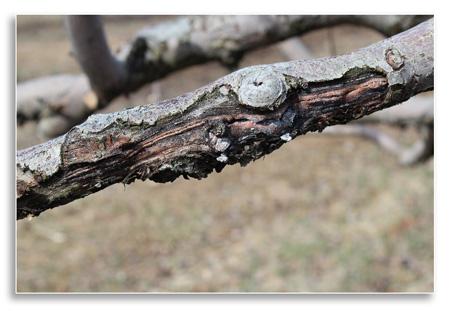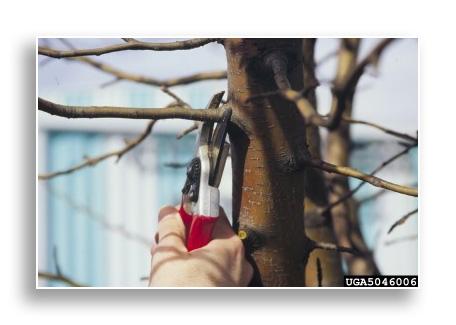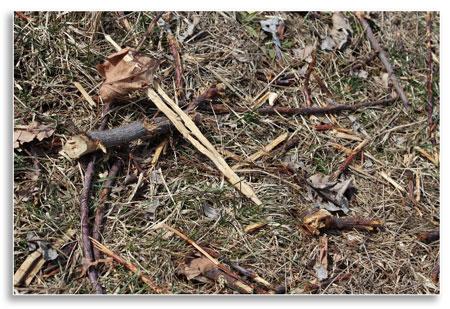Plant Health: Landscape Sanitation
By Kimberly Leonberger & Nicole Ward Gauthier
Autumn has arrived in Kentucky and, as leaves change color and fall from trees, it is time to focus on landscape sanitation. Good sanitation practices can help reduce disease-causing pathogens. These organisms can survive for months or years on dead plant material or in soil, causing infections in subsequent years. Elimination of disease-causing organisms reduces the need for chemical controls and can improve the effectiveness of disease management practices. Following these sanitation practices both in autumn and throughout the growing season can reduce disease pressure in home and commercial landscapes.
Sanitation Practices:
- Remove diseased plant tissues from infected plants
- Prune cankers (Photo 1) and galls from branches by making cuts well below visible symptoms (Photo 2). Clean tools between each cut with a sanitizer, such as rubbing alcohol or household bleach.
- Rake and remove fallen buds, flowers, twigs, leaves, and needles (Photo 3)

Cankers can provide an overwintering spot for plant pathogens. 
When removing cankers, make cuts well below visible symptoms or at the base of branches.
Fallen leaves, and other plant parts should be gathered and discarded.
- Discard all above and below ground portions of heavily infected perennial and annual plants. Severely infected trees and shrubs should be cut down and stumps removed/destroyed.
- All discarded plant material should be burned, buried, or removed with yard waste. Do not compost diseased plant material. Exercise caution when storing limbs and trunks as fire wood or using for mulch.
- Soil from containers should be discarded and not reused.
- Remove weeds, including roots, which may serve as alternate hosts for pathogens.
- When treating infected plants with fungicides, remove infected tissues prior to application.
For Additional Information:
Photography
- Cankers can provide an overwintering site for plant pathogens (N. Ward Gauthier, University of Kentucky)
- Pruning off diseased branches at the base (Joseph O'Brien, USDA Forest Service, Bugwood.org)
- Plant debri from diseased plants should be discarded (N. Ward Gauthier, University of Kentucky)
About the Authors
Dr. Nicole Ward Gauthier is an Extension Associate Professor in the University of Kentucky Department of Plant Pathology. Her focus includes diseases of ornamentals (landscape, nursery and greenhouse) and fruit crops. Email at nicole.ward@uky.edu
Kimberly Leonberger is an Agriculture Extension Associate in the University of Kentucky Department of Plant Pathology. Email at kimberly.leonberger@uky.edu
